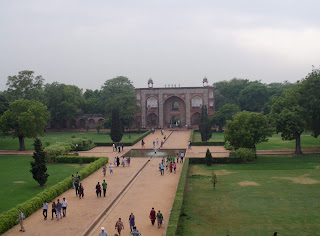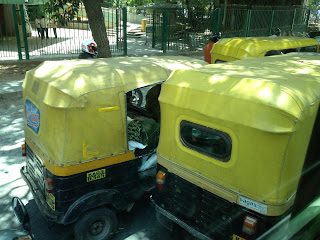OK, even though I have been a teacher for more years than I like to recall, I still get a little nervous on the first day of school. It isn’t the nerves of will they like me, I am not concerned about that, but more of how will these personalities mesh with each other. I know my content and I know how to teach but the interactions of each class differ because of the student dynamics. This means that I have to alter my presentations and manner of instruction to best fit the make-up of the class.
Not only will I have my normal first day with my three classes when school starts back in August; I had my first day in India with nine classes. That is right, nine classes and the school day is 7:25 - 3:15. So my day with students begins earlier and ends later than I am used to (I know I am normally never there that early but I stay later and I don’t have students late in the afternoon).
The day begins with me walking to the gate of the complex to be picked up by one of the other teachers, if that hadn’t worked out I could have walked or taken my new favorite form of transportation, the auto-rickshaw. We quickly get to school and navigate through the throngs of parents and drivers dropping off students for their first day back after summer holidays.
I meet one of the teachers that I am going to teach with and walk to her classroom. She has the students lined up to report for the whole school assembly. She teaches grade 9 and I walk with her as she lines the students up on their step of the amphitheater and then I notice it; the boys are shoving and poking and thumping each other. I wasn’t sure how the students were going to act; this was one of the elite private schools in New Delhi and there are the 9th grade boys shoving each other, gee that looks familiar. Their teacher kept separating them and standing close to them and guess what, I was doing the same thing. Imagine, the teacher death stare is the same in other countries. After a while the boys settled down and the assembly began. Announcements were made and the national anthem was sung and then the students went back to their classrooms.
I spent the first two periods of the day learning the layout of the school with my host teacher, Mona. We saw the upper school, grades 6-12 on the one side of the amphitheater and the lower school, elementary aged on the other side. Since neither of us teaches elementary age students, it was a quick tour through their facilities.
If I haven’t expressed it before, New Delhi is hot. Students had already gotten an extended summer break because of the intense heat. The temperature is well into the 90’s before noon with oppressive humidity. I know ever year I threaten to spend my summers somewhere cooler than North Carolina and where do I do someplace with weather even hotter. Oh and if I forgot to mention it, the classrooms do not have air conditioning.
So I have just climbed to the third floor, to teach ninth graders world history in a classroom lacking air conditioning and I feel like I am going to melt into a puddle and die. I present the information about my school and the only real question I got was “Is your school air conditioned” and when I answered “yes” you should have seen the glares directed at the teacher. Even though I had seen the morning behaviors I still wasn’t quite sure what to expect. I think that I was expecting perfection, little student robots quietly doing everything asked of them without any comment or protest. What I saw was quite different, I saw students begging for a smaller homework assignment, getting chastised for not taking notes or paying attention. In general, the students acted like a normal class of American students.
In all of the classes that I was in, I presented a little about North Carolina and the school where I teach, Starmount High. The students were interested in the fact that my students, if they had their license could drive to school (they cannot), there are no uniforms (they have them), we have air conditioned classrooms, and students can have cell phones (they are not allowed at school).
 |
| Partial schedule of one classroom. You can see how the subject order switches. |
What I found interesting was that the class stays together and the teacher comes to them, with the exceptions of PE, arts, and lab classes. They also did not have the same schedule every day. In all of the classes the weeks schedule was posted and their classes alternated class periods and some classes were double lessons. There was also a private study build into the day, a study hall in which every student was provided one class period to work on homework at school and they could get a teacher’s help during that time. The homework schedule was also posted, as to which classes would have official homework assignments that would be due the next day. There were at most three classes of assigned homework a night, with maths and sciences having the most days of assigned homework. But, before my students get to happy, I was told that the average was two hours of homework a night.
I taught two different history lessons, I taught the between the war years German history or the rise of Hitler, and Roman history and culture. These were to the grade 9 and 11 classes. I also observed other social science classes throughout the day. The students were willing to participate in discussion and asked good questions.
The lessons that I taught were all before lunch, which is at 1:33 and the whole school has 25 minutes to eat their lunch. Before you ask, “How big is the cafeteria?”; there isn’t one. The meals are brought outside of the classrooms and students get their lunch and take it to the stairs, hallways, or classrooms and eat. There is only one choice and all students are provided the same meal. The meal choice is also vegetarian. Some students also brought snacks to eat during the morning breaks.
 |
| Students during lunch period. |
As for me by the end of the day I was exhausted. I am always a little wiped out the first student day after summer break but this was different. I have never taught in a day that long or in such intense heat.

















